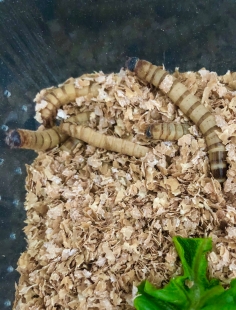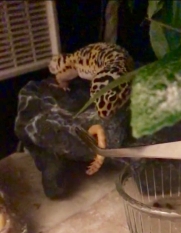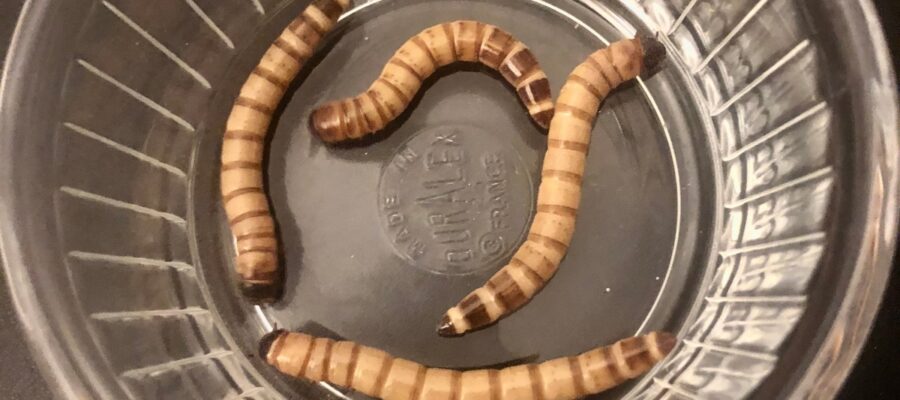Morio Worms (which are also referred to as Superworms or Kingworms) are the latest leopard gecko feeder insects that I will be reviewing.
It’s important to feed your geckos a varied diet of live food, because each different insect offers different nutrition and benefits, and also it’s nice for your geckos to have some variety, as their tastes and preferences can change as they age.
For some frequently asked questions I receive around my leopard geckos’ diets, please see my Leopard Gecko Feeder Insects FAQ post.
Morio Worm care
These guys are really easy to look after. If you’ve ever used mealworms as a feeder insect, then the care is pretty much the same.
 They come in a box filled with some sort of substrate like bran, oats or sandpaper, and they should be fine to stay in these boxes unless perhaps you want to breed them and create a larger colony.
They come in a box filled with some sort of substrate like bran, oats or sandpaper, and they should be fine to stay in these boxes unless perhaps you want to breed them and create a larger colony.
I keep their substrate topped up with oats, and then gutload them with vegetables, which varies depending on what’s in my fridge. It’s better to use less juicy vegetables, such as carrots, celery or potatoes, as they will cause less condensation/ mould while still providing the worms with adequate hydration.
It is also possible to feed them with a pre-mixed gutloader, but I don’t find this to be essential.
Nutrition
Morio Worms are packed with fat (55%) and protein (45%), but for this reason they should not be used as a staple feeder as it could cause your leopard geckos to become overweight. They should be fed as part of a varied and well-balanced diet.
As with mealworms, morio worms should be dusted with calcium powder as the levels o calcium in are not very high, although I do find it doesn’t stick as well to morio worms unless you spray the worms with a little water first.
These worms are also big, and have a hard exoskeleton, so it is advisable not to give them to young or juvenile leopard geckos, who would probably do better to be fed on the much-smaller mealworm.
They don’t smell/ make noise
Morio worms do not smell, and they don’t make noise, apart from if you get close you can sometimes hear them shuffling around in their container.
They move loads
 Morio worms wriggle loads which is great for leopard geckos, as this catches their eye and they are more likely to show an interest in it.
Morio worms wriggle loads which is great for leopard geckos, as this catches their eye and they are more likely to show an interest in it.
I find them particularly wiggly when put between tweezers and fed to the geckos, and because of their hard exoskeleton they are not too delicate, so you’re unlikely to crush them by doing this.
I love feeding my geckos in this way!
They can’t climb smooth surfaces
I prefer to use insects that can’t climb out of smooth surfaces, because both of my leopard geckos are lazy hunters, and with insects that can get away (such as locusts) my lazy geckos usually don’t stand a change.
I put my feeder insects in smooth clear ramekins so my geckos can easily catch them, with another added benefit here being the worms tend to stay nicely dusted in calcium powder as they will keep wriggling through it in the bottom of the dish, until they get eaten.
Do Morio Worms bite?
Morio worms do have reasonably strong mandibles can pose a very slight danger to your leopard geckos, but this can be averted by putting them in a smooth-sided dish, where they can’t escape.
Cost
Morio worms are cheap, and from my experience are hardy insects which seem to live for ages, which makes them even more worth their money.
Summary
Overall, I really like morio worms, and I much prefer them to mealworms. I find them easy to care for, easier to feed to my leopard geckos, and my geckos seem to show them more interest than other insects because they’re so wriggly.
Ease of care: 8/10
Nutritional profile: 6/10
Smell/ Noise: 8/10
Movement: 9/10
Ease of containing: 8/10
Cost: 9/10
Get Your Free Leopard Gecko Care Checklist!
Are you ready to give your leopard gecko the best care possible? Download our FREE PDF e-book featuring a comprehensive care checklist!
This handy guide covers everything from habitat setup to feeding and health tips, ensuring your gecko thrives.
👉 Download your checklist now!




